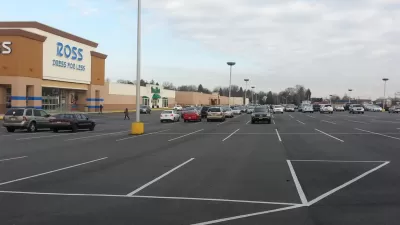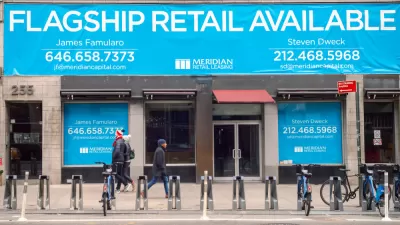As brick and mortar retailers shed jobs and stores, suburbs will lose the most in terms of tax revenues and amenities.

"It has been a decade since the media declared the death of the mall, in a year that would be the first in a half-century that no new malls were built in America," Henry Garbar writes for Slate. The closings have been widespread and deep. "The Limited, a women’s clothing store, shut down 250 stores and laid off 4,000 workers earlier this year. Sears Holdings will close 150 stores, including 108 Kmarts, and Macy’s will close another 100," Garbar reports.
This constriction of retail will affect suburbs more profoundly than it will affect cities, Garbar argues, and to understand why, you have to understand why malls moved to suburbs in the first place. Malls offered tax incentives and cheap land for large projects. This happened when retail was relatively robust. Now that there are fewer stores to go around, the competition will only become more fearsome."As shopping centers fold, developers of would-be projects will gain more power relative to suburban municipalities that already compete tooth-and-nail to steal each other’s business," Garbar writes. The result will be a race to the bottom and suburbs will be squeezed, whether or not they can accommodate these malls. To survive, Garbar opines, they'll have to look for new solutions.
FULL STORY: The Retail Apocalypse Is Suburban

Planetizen Federal Action Tracker
A weekly monitor of how Trump’s orders and actions are impacting planners and planning in America.

San Francisco's School District Spent $105M To Build Affordable Housing for Teachers — And That's Just the Beginning
SFUSD joins a growing list of school districts using their land holdings to address housing affordability challenges faced by their own employees.

The Tiny, Adorable $7,000 Car Turning Japan Onto EVs
The single seat Mibot charges from a regular plug as quickly as an iPad, and is about half the price of an average EV.

Seattle's Plan for Adopting Driverless Cars
Equity, safety, accessibility and affordability are front of mind as the city prepares for robotaxis and other autonomous vehicles.

As Trump Phases Out FEMA, Is It Time to Flee the Floodplains?
With less federal funding available for disaster relief efforts, the need to relocate at-risk communities is more urgent than ever.

With Protected Lanes, 460% More People Commute by Bike
For those needing more ammo, more data proving what we already knew is here.
Urban Design for Planners 1: Software Tools
This six-course series explores essential urban design concepts using open source software and equips planners with the tools they need to participate fully in the urban design process.
Planning for Universal Design
Learn the tools for implementing Universal Design in planning regulations.
Smith Gee Studio
City of Charlotte
City of Camden Redevelopment Agency
City of Astoria
Transportation Research & Education Center (TREC) at Portland State University
US High Speed Rail Association
City of Camden Redevelopment Agency
Municipality of Princeton (NJ)




























